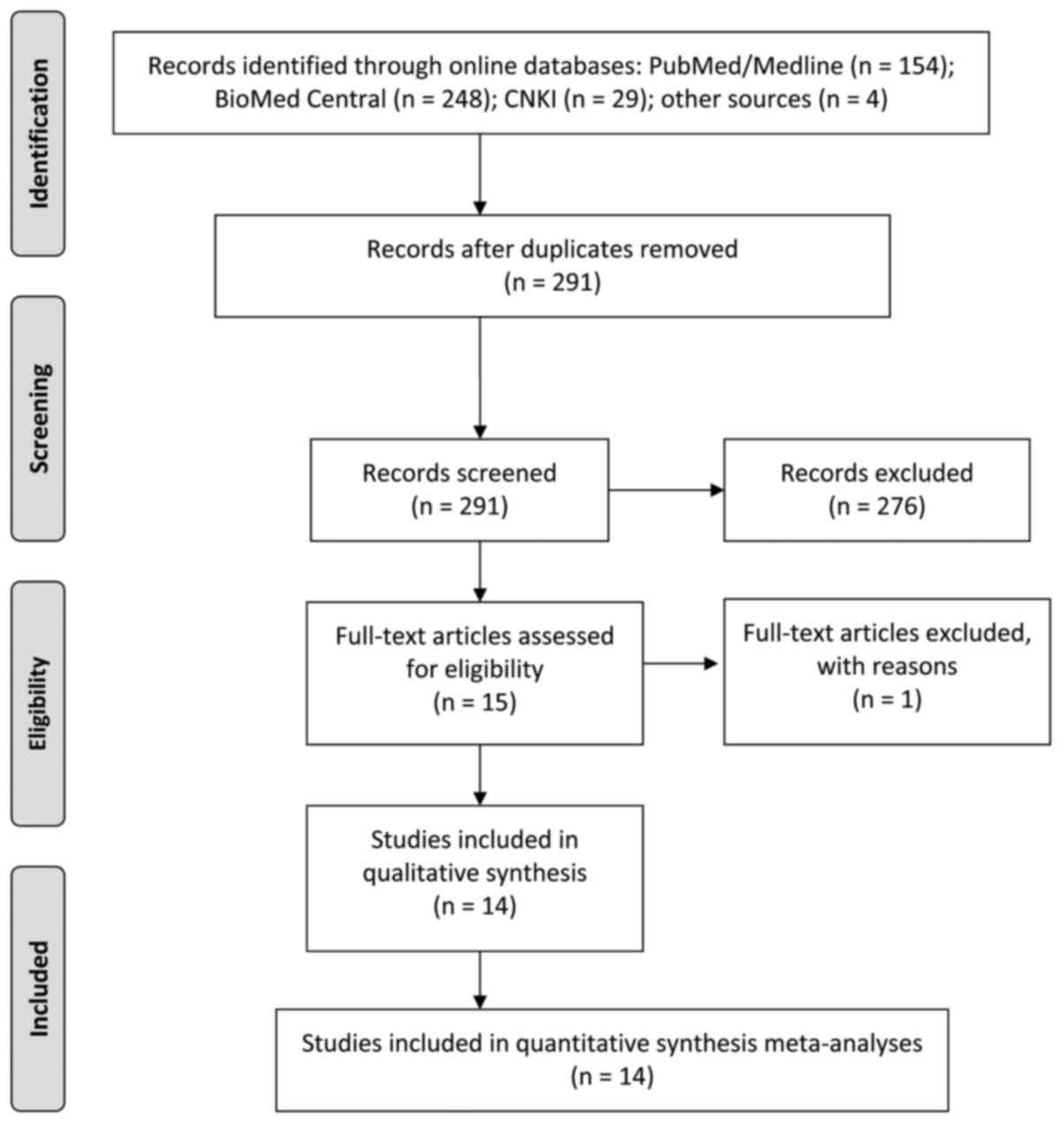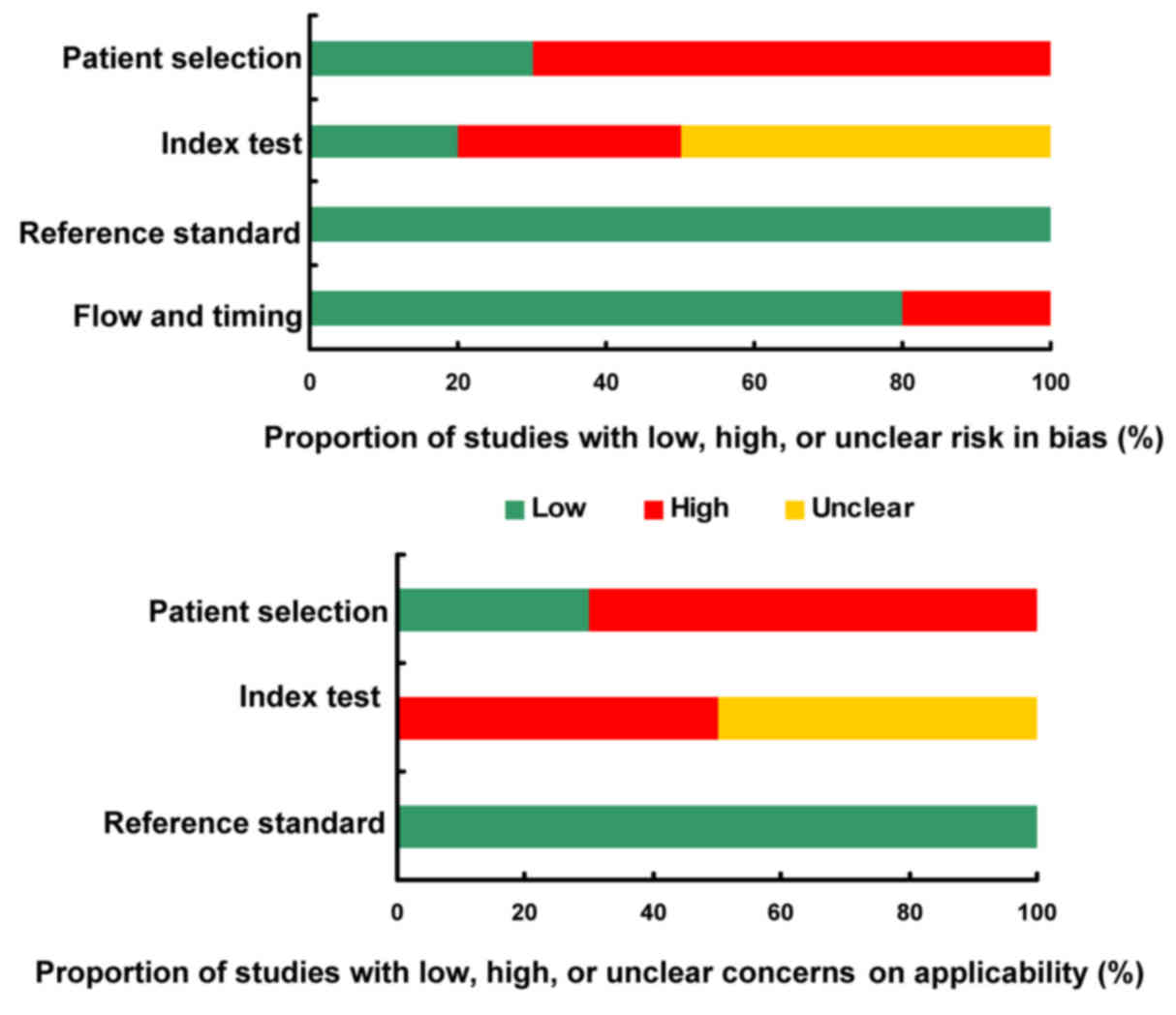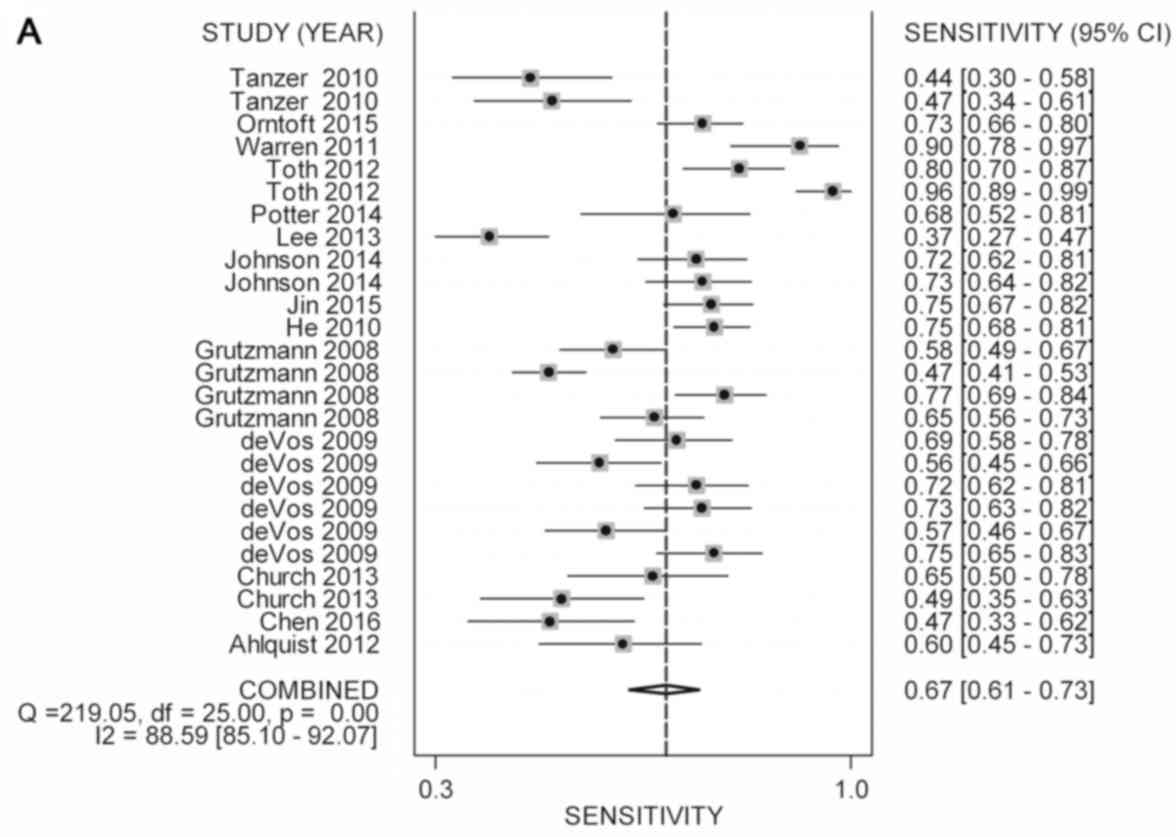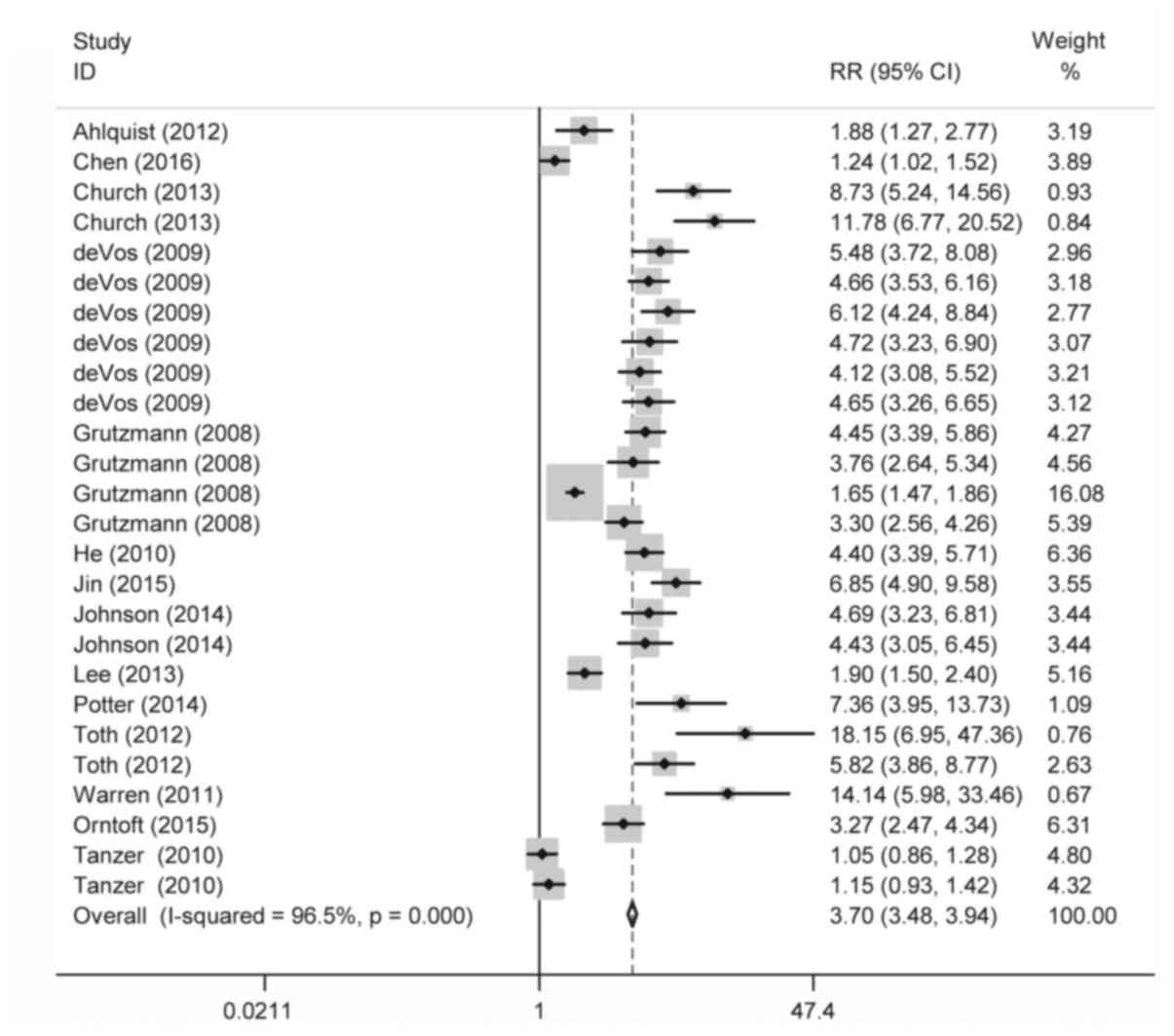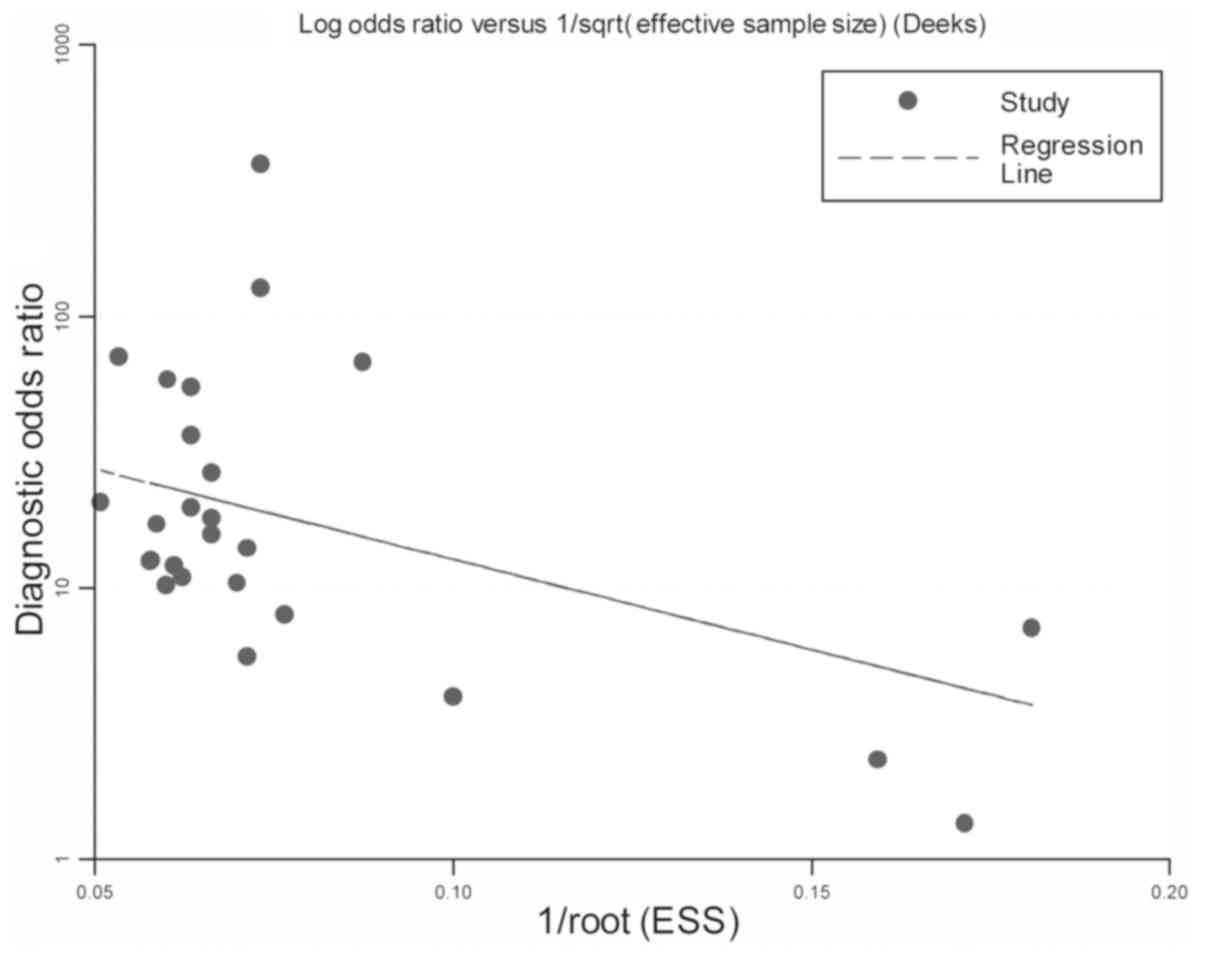A pooled analysis of the diagnostic efficacy of plasmic methylated septin-9 as a novel biomarker for colorectal cancer
- Authors:
- Published online on: August 21, 2017 https://doi.org/10.3892/br.2017.970
- Pages: 353-360
Abstract
Introduction
Colorectal cancer (CRC) remains one of the leading cancers worldwide. According to the newly issued cancer statistics in China, between 2000 and 2011, CRC ranked as the third and fifth cause of mortality among females and males, respectively (1). In clinic, the management of CRC at an early stage continues to be the main approach to reduce mortality and morbidity (2). Nevertheless, early and accurate diagnosis have posed a challenge for the diagnosis of CRC due to a lack of high sensitivity and specific tumor markers or detection techniques in clinic (3).
Epigenetic modifications such as gene or DNA methylation in tumors have placed increased attention on the early identification of CRC. Among the methylated genes in CRC, septin-9 has been highlighted as an ideal candidate biomarker (4–19). Septin-9 was initially identified in myeloid neoplasia (20). It acts as a suppressor gene in numerous cancer types (21,22). In previous years, an increasing number of studies have focused on the investigation of plasma methylated septin-9 for the detection of CRC (4–17). Consequently, several types of assay kits regarding methylated septin-9 are being developed and have become commercial products. Nevertheless, results from single studies are often inconsistent due to limited sample size and single-center design. For instance, some studies reported that septin-9 testing presented a limited sensitivity from 51 to 56% (14,15). By constrast, some research presented an estimated sensitivity of septin-9 methylation up to 90% (6).
In the present study, we conducted a comprehensive meta-analysis and assessed the overall diagnostic efficacy of plasma methylated septin-9 for CRC detection.
Materials and methods
Search strategy
Two reviewers independently searched the published articles through the online PubMed/Medline, BioMed Central and CNKI databases up to January 31st, 2017. The search terms were utilized in a single or parallel pattern as (‘septin-9’ or ‘septin 9’) and (‘colon cancer’ or ‘colorectal neoplasm’ or ‘CRC’ or ‘colorectal carcinoma’ or ‘carcinoma of colon’) and/or (‘sensitivity’ or ‘specificity’ or ‘diagnosis’ or ‘accuracy’ or ‘ROC’ or ‘AUC’. We also manually searched the references in the studies for retrieval.
Eligibility criteria
Inclusion criteria for the meta-analysis were: i) Studies estimated the diagnostic feature of plasma septin-9 for CRC; ii) studies with sufficient information to generate the statistical elements as true positive, true negative, false positive and false negative; and iii) the control sources were from cancer-free individuals.
Studies were excluded based on the following criteria: i) studies with unclear definition of the control sources or the paired controls were other types of tumors; ii) extracted data were insufficient to establish the 2×2 table; and iii) basic studies, review articles, letters and conference articles.
Data extraction
Essential data from enrolled articles were extracted twice by two authors and the information included: The name of the author, publication data, study population, sample numbers, control types, measure method, cut-off value, sensitivity, and specificity. The two-stage study comprised both training and validation cohorts, and the data from each group were considered to be independent and were meta-analyzed as individual studies. Any disagreements on data extraction were solved by group discussion.
Study bias assessment
Study bias of the included articles was judged according to the Quality Assessment of Studies of Diagnostic Accuracy included in the Systematic Reviews (QUADAS) II checklist (23), wherein, the concerns for risk of bias and applicability were rated as ‘low’, ‘high’ or ‘unclear’, with an evaluation score of ‘1’, ‘0’ and ‘0’, respectively.
Statistical analyses
The quantitative meta-analyses were carried out based on Stata 12.0 (StataCorp LP, College Station, TX, USA) and Meta-disc 1.4 (XI Cochrane Colloquium, Barcelona, Spain) programs using a bivariate quantitative model. Heterogeneity among the studies was estimated utilizing Spearman's correlation coefficient, I-squared (I2) and Chi-squared (χ2) Q tests. Either P<0.05 or I2>50% were deemed as statistically different (24). If significant heterogeneity existed among studies, a random-effect model was employed for the aggregation of the effect sizes; otherwise, a fixed-effect model was used (25). Potential sources of heterogeneity were traced by influence analysis and meta-regression test. Bias of the publications was determined using Deek's funnel plot asymmetry test. P<0.05 was considered to indicate a statistically significant difference.
Results
Article filtration and quality assessment
Fig. 1 shows the procedure of article filtration based on the PRISMA statement: In total, 291 citations were obtained from the online databases according to the specified criteria, of which 276 records were excluded after a careful review of the title and abstracts. The following 15 eligible studies then received full text evaluation and 1 of them was eliminated due to lack of relevance (26). Finally, 14 cohorts comprising 23 single studies were enrolled for the meta-analysis (4–17).
The study quality of the included cohorts was assessed by the QUADAS II tool (23). Fig. 2 plots the proportions of studies with low, high, or unclear concerns regarding risk of bias and applicability and the included studies showed low risk of bias.
Study features
In the current study, 1,462 CRC patients and 4,703 CRC-free subjects were enrolled for the final meta-analyses. The CRC patients enrolled had not previously undergone treatment and the final diagnoses were confirmed histologically via the surgical specimen. The control sources comprised healthy participants, hyperplastic polyps and individuals with normal colonoscopy examinations. The patient size varied from 30 to 252 and the control size varied from 9 to 1,500. Blood samples were collected and tested in plasma and the methylated status of septin-9 was examined via the qPCR. The reference genes involved, β-actin, CFF1 and HB14 were employed for determining the validity of the results. Study ethnicity comprised Asian, American and European. The main characteristics of included studies are summarized in Table I.
Table I.Main features of the included studies for plasma septin-9 methylation in the identification of CRC. |
Heterogeneity
Heterogeneity underlying eligible studies was mirrored by the examination of threshold and non-threshold effects among studies (25,27). As shown in Table II, Spearman's correlation coefficient of the overall effect size revealed a P>0.05, suggesting that no significant heterogeneity generated from the threshold effect. Moreover, I2 and χ2-based Q tests were conducted to evaluate heterogeneity caused by the non-threshold effect. As the data indicated, either the overall pooled analysis (Q=111.58, P<0.01, I2=77.6%) or the stratified analyses (Table II) presented significant heterogeneity from the threshold effect. As a result, we selected a random-effect model for the aggregation of the effect sizes.
Pooled diagnostic performance
For efficacy when differentiating CRC patients from non-CRC ones, methylated septin-9 in plasma retained a combined sensitivity of 0.67 (95% CI, 0.61–0.73) and specificity of 0.89 (95% CI, 0.86–0.92) (Fig. 3A and B and Table III). Moreover, the pooled positive likelihood ratio (PLR), negative likelihood ratio (NLR), diagnostic odds ratio (DOR) and AUC were 6.26 (95% CI, 4.76–8.22), 0.37 (95% CI, 0.31–0.44), 16.93 (95% CI, 11.56–24.77) and 0.87, respectively (Fig. 3C and Table III).
Table III.The pooled analyses of diagnostic efficacy of methylated septin-9 in confirming colorectal cancer. |
Subgroup analyses
In the stratified studies analyzed according to ethnicity, the data demonstrated that European-based septin-9 methylation test had the optimal sensitivity of 0.72 (95% CI, 0.68–0.76), whereas the Asian-based analysis achieved the highest specificity of 0.90 (95% CI, 0.88–0.92) (Table III). In addition, testing of septin-9 in Americans conferred a sensitivity of 0.64 (95% CI, 0.62–0.67) at a specificity of 0.89 (95% CI, 0.88–0.90), corresponding to an AUC of 0.85, PLR of 5.99 (95% CI, 4.72–7.61), NLR of 0.38 (95% CI, 0.33–0.45) and DOR of 17.18 (95% CI, 12.78–23.10) (Table III).
Influence analysis and meta-regression
Influence analysis and meta-regression test were applied to deeply analyze the characteristics of included studies to better explain the sources of heterogeneity. As indicated by Fig. 4, four individual studies were evaluated as outliers. We further adjusted the analyses by removing the outlier studies. Accordingly, the combined effects size of sensitivity elevated from 0.67 to 0.70, NLR was reduced from 0.37 to 0.33 and I2 increased from 77.6 to 77.2%. On the other hand, the univariate meta-regression test was applied to further trace the underlying sources of study heterogeneity. We conducted the test relying on six predefined covariates: Study ethnicity (Asian vs. American vs. European), CRC cases (<100 vs. ≥100), control size (control <100 vs. control ≥100), reference gene (β-actin vs. other), test algorithms (1/3 vs 2/3 algorithm) and article quality (QUADAS scores) (28). However, all these factors showed a low likelihood of causes of heterogeneities (Table IV).
Publication bias
Risk of bias among publications was examined by the Deeks' funnel plot asymmetry test among the included studies. In Fig. 5, the slope coefficient of the regression line exhibited a P-value of 0.193, suggesting that no clear bias existed among the eligible studies due to publication.
Discussion
Methylated septin-9 has recently been developed as a novel, non-invasive biomarker for CRC diagnosis (2,3). The technique has developed rapidly for the testing of plasmic septin-9 methylation and several kinds of assay kits have been developed and become commercial products (22). The current meta-analysis assessed the diagnostic utility of plasma methylated septin-9 as a serological marker for the identification of CRC.
Our analysis revealed that the overall testing of methylated septin-9 in plasma retained a relatively low sensitivity of 0.67, but maintained a high specificity of 0.89. In the SROC curve analysis, the combined AUC was estimated to be 0.87, revealing a relatively high efficacy for the septin-9 methylation testing in the diagnosis of CRC. The DOR is also recommended as an important indicator in mirroring the overall diagnostic performance (24). In the present study, the DOR of plasmic septin-9 methylation test was shown to be 16.93, suggesting a powerful discriminatory performance in confirming CRC. Moreover, a pooled PLR of 6.26 means that testing of methylated septin-9 in plasma reached a ratio of 6.26 between the true and false-positive rate. For the false-negative rate reflected by NLR (25), the value was estimated to be 0.37, which is not low enough to eliminate CRC. In general, our data have shown that analysis of methylated septin-9 in plasma achieved an overall high efficacy and is acceptable as a routine biomarker for CRC detection.
Recent evidence has substantiated an independent association between ethnicity and DNA methylation status (29). We therefore further conducted a stratified analysis according to ethnicity. Our findings revealed that testing of septin-9 methylation in Asians and Europeans achieved a better efficacy than in Americans. Nevertheless, our analysis stratified by ethnicity yielded a small study size and exhibited high heterogeneity. Thus, more investigations are required to confirm our findings.
On the other hand, we observed a large degree of heterogeneity in our meta-analyses. Heterogeneity can be interpreted by both threshold and non-threshold effects (25,27). The threshold effect can be caused by different cut-off value settings as well as objective methods. In the present study, the P-values from Spearman's correlation coefficient were >0.05, suggesting that there was no clear heterogeneity from the threshold effect. Nevertheless, significant heterogeneity from the non-threshold effect seemed to be present in all the meta-analyses as well as in the subgroup analyses. The causes of heterogeneity from the non-threshold effect can be interpreted by the different disease conditions and other concomitant diseases among the participants. In addition, different test conditions involved in the detection technique, operators as well as standard tests also constitute major causes of non-threshold effect (25). In the present study, we hypothesized that the outlier studies, ethnicity, case or control size, reference gene, cut-off value setting and study quality may contribute to the sources of heterogeneity. As a result, we first conducted influence analysis and identified four outlier studies. After removing the outliers, the pooled sensitivity was elevated from 0.67 to 0.70, NLR was reduced from 0.37 to 0.33, but I2 was elevated from 77.6 to 77.2%. Accordingly, we further conducted a meta-regression test and found that variations such as ethnicity, case or control size, reference gene, test algorithms and article quality were not likely to be sources of heterogeneity among eligible studies.
Our analysis has several limitations. Firstly, a large number of heterogeneities were observed in our analyses, which compromised the pooled accuracy of the effect sizes. Secondly, the sample numbers in the subgroup studies were small and the findings require verification. Finally, the control types were complicated and thus the meta-analyzed data may not completely mirror the real diagnostic efficacy of plasma septin-9 methylation for CRC detection.
Despite these limitations, plasma methylated septin-9 testing showed a relatively high accuracy and may be optimal for CRC diagnosis. Further investigations are required to confirm the preliminary evidence from the present study.
References
|
Chen W, Zheng R, Baade PD, Zhang S, Zeng H, Bray F, Jemal A, Yu XQ and He J: Cancer statistics in China 2015. CA Cancer J Clin. 66:115–132. 2016. View Article : Google Scholar : PubMed/NCBI | |
|
Kolligs FT: Diagnostics and epidemiology of colorectal cancer. Visc Med. 32:158–164. 2016. View Article : Google Scholar : PubMed/NCBI | |
|
Nguyen MT and Weinberg DS: Biomarkers in colorectal cancer screening. J Natl Compr Canc Netw. 14:1033–1040. 2016. View Article : Google Scholar : PubMed/NCBI | |
|
Potter NT, Hurban P, White MN, Whitlock KD, Lofton-Day CE, Tetzner R, Koenig T, Quigley NB and Weiss G: Validation of a real-time PCR-based qualitative assay for the detection of methylated SEPT9 DNA in human plasma. Clin Chem. 60:1183–1191. 2014. View Article : Google Scholar : PubMed/NCBI | |
|
Lee HS, Hwang SM, Kim TS, Kim DW, Park DJ, Kang SB, Kim HH and Park KU: Circulating methylated septin 9 nucleic acid in the plasma of patients with gastrointestinal cancer in the stomach and colon. Transl Oncol. 6:290–296. 2013. View Article : Google Scholar : PubMed/NCBI | |
|
Tóth K, Sipos F, Kalmár A, Patai AV, Wichmann B, Stoehr R, Golcher H, Schellerer V, Tulassay Z and Molnár B: Detection of methylated SEPT9 in plasma is a reliable screening method for both left-and right-sided colon cancers. PLoS One. 7:e460002012. View Article : Google Scholar : PubMed/NCBI | |
|
Warren JD, Xiong W, Bunker AM, Vaughn CP, Furtado LV, Roberts WL, Fang JC, Samowitz WS and Heichman KA: Septin 9 methylated DNA is a sensitive and specific blood test for colorectal cancer. BMC Med. 9:1332011. View Article : Google Scholar : PubMed/NCBI | |
|
Ahlquist DA, Taylor WR, Mahoney DW, Zou H, Domanico M, Thibodeau SN, Boardman LA, Berger BM and Lidgard GP: The stool DNA test is more accurate than the plasma septin-9 test in detecting colorectal neoplasia. Clin Gastroenterol Hepatol. 10:272–277. 2012. View Article : Google Scholar : PubMed/NCBI | |
|
Grützmann R, Molnar B, Pilarsky C, Habermann JK, Schlag PM, Saeger HD, Miehlke S, Stolz T, Model F, Roblick UJ, et al: Sensitive detection of colorectal cancer in peripheral blood by septin 9 DNA methylation assay. PLoS One. 3:e37592008. View Article : Google Scholar : PubMed/NCBI | |
|
Chen CH, Yan SL, Yang TH, Chen SF, Yeh YH, Ou JJ, Lin CH, Lee YT and Chen CH: The relationship between the methylated septin-9 DNA blood test and stool occult blood test for diagnosing colorectal cancer in Taiwanese people. J Clin Lab Anal. Jul 8–2016.(Epub ahead of print). | |
|
He Q, Chen HY, Bai EQ, Luo YX, Fu RJ, He YS, Jiang J and Wang HQ: Development of a multiplex MethyLight assay for the detection of multigene methylation in human colorectal cancer. Cancer Genet Cytogenet. 202:1–10. 2010. View Article : Google Scholar : PubMed/NCBI | |
|
Jin P, Kang Q, Wang X, Yang L, Yu Y, Li N, He YQ, Han X, Hang J, Zhang J, et al: Performance of a second-generation methylated SEPT9 test in detecting colorectal neoplasm. J Gastroenterol Hepatol. 30:830–833. 2015. View Article : Google Scholar : PubMed/NCBI | |
|
Johnson DA, Barclay RL, Mergener K, Weiss G, König T, Beck J and Potter NT: Plasma Septin9 versus fecal immunochemical testing for colorectal cancer screening: A prospective multicenter study. PLoS One. 9:e982382014. View Article : Google Scholar : PubMed/NCBI | |
|
Church TR, Wandell M, Lofton-Day C, Mongin SJ, Burger M, Payne SR, Castaños-Vélez E, Blumenstein BA, Rösch T, Osborn N, et al: PRESEPT Clinical Study Steering Committee, Investigators and Study Team: Prospective evaluation of methylated SEPT9 in plasma for detection of asymptomatic colorectal cancer. Gut. 63:317–325. 2014. View Article : Google Scholar : PubMed/NCBI | |
|
deVos T, Tetzner R, Model F, Weiss G, Schuster M, Distler J, Steiger KV, Grützmann R, Pilarsky C, Habermann JK, et al: Circulating methylated SEPT9 DNA in plasma is a biomarker for colorectal cancer. Clin Chem. 55:1337–1346. 2009. View Article : Google Scholar : PubMed/NCBI | |
|
Tänzer M, Balluff B, Distler J, Hale K, Leodolter A, Röcken C, Molnar B, Schmid R, Lofton-Day C, Schuster T and Ebert MP: Performance of epigenetic markers SEPT9 and ALX4 in plasma for detection of colorectal precancerous lesions. PLoS One. 5:e90612010. View Article : Google Scholar : PubMed/NCBI | |
|
Ørntoft MB, Nielsen HJ, Ørntoft TF and Andersen CL; and Danish Study Group on Early Detection of Colorectal Cancer, . Performance of the colorectal cancer screening marker Sept9 is influenced by age, diabetes and arthritis: A nested case-control study. BMC Cancer. 15:8192015. View Article : Google Scholar : PubMed/NCBI | |
|
Powrózek T, Krawczyk P, Kucharczyk T and Milanowski J: Septin 9 promoter region methylation in free circulating DNA-potential role in noninvasive diagnosis of lung cancer: Preliminary report. Med Oncol. 31:9172014. View Article : Google Scholar : PubMed/NCBI | |
|
Lyu N, Yao H, Xiao T, Gao Y and Wu L: [Protein levels and its clinical significance of septin-9 and clusterin in peripheral blood of epithelial ovarian cancer patients). Zhonghua Fu Chan Ke Za Zhi. 50:679–684. 2015.(In Chinese). PubMed/NCBI | |
|
Kreuziger LM, Porcher JC, Ketterling RP and Steensma DP: An MLL-SEPT9 fusion and t(11;17) (q23;q25) associated with de novo myelodysplastic syndrome. Leuk Res. 31:1145–1148. 2007. View Article : Google Scholar : PubMed/NCBI | |
|
Bennett KL, Karpenko M, Lin MT, Claus R, Arab K, Dyckhoff G, Plinkert P, Herpel E, Smiraglia D and Plass C: Frequently methylated tumor suppressor genes in head and neck squamous cell carcinoma. Cancer Res. 68:4494–4499. 2008. View Article : Google Scholar : PubMed/NCBI | |
|
Molnár B, Tóth K, Barták BK and Tulassay Z: Plasma methylated septin 9: A colorectal cancer screening marker. Expert Rev Mol Diagn. 15:171–184. 2015. View Article : Google Scholar : PubMed/NCBI | |
|
Whiting PF, Rutjes AW, Westwood ME, Mallett S, Deeks JJ, Reitsma JB, Leeflang MM, Sterne JA and Bossuyt PM: QUADAS-2 Group: QUADAS-2: A revised tool for the quality assessment of diagnostic accuracy studies. Ann Intern Med. 155:529–536. 2011. View Article : Google Scholar : PubMed/NCBI | |
|
Wang Y, Pei F, Wang X, Sun Z, Hu C and Dou H: Diagnostic accuracy of fecal lactoferrin for inflammatory bowel disease: A meta-analysis. Int J Clin Exp Pathol. 8:12319–12332. 2015.PubMed/NCBI | |
|
Cao FF, Yu S, Jiang ZY and Bao YX: Diagnostic accuracy of Golgi protein 73 in primary hepatic carcinoma using ELISA: A systematic review and meta-analysis. Clin Lab. 60:587–597. 2014. View Article : Google Scholar : PubMed/NCBI | |
|
Tóth K, Galamb O, Spisák S, Wichmann B, Sipos F, Valcz G, Leiszter K, Molnár B and Tulassay Z: The influence of methylated septin 9 gene on RNA and protein level in colorectal cancer. Pathol Oncol Res. 17:503–509. 2011. View Article : Google Scholar : PubMed/NCBI | |
|
Wang C, Zhao K and Rong Q: Diagnostic value of fecal MicroRNAs for colorectal cancer: A meta-analysis. Clin Lab. 61:1845–1853. 2015. View Article : Google Scholar : PubMed/NCBI | |
|
Cui Z, Chen Y, Xiao Z, Hu M, Lin Y, Chen Y and Zheng Y: Long noncoding RNAs as auxiliary biomarkers for gastric cancer screening: A pooled analysis of individual studies. Oncotarget. 7:25791–25800. 2016. View Article : Google Scholar : PubMed/NCBI | |
|
Zhu H, Bhagatwala J, Huang Y, Pollock NK, Parikh S, Raed A, Gutin B, Harshfield GA and Dong Y: Correction: Race/ethnicity-specific association of vitamin D and global DNA methylation: Cross-sectional and interventional findings. PLoS One. 11:e01625822016. View Article : Google Scholar : PubMed/NCBI |



